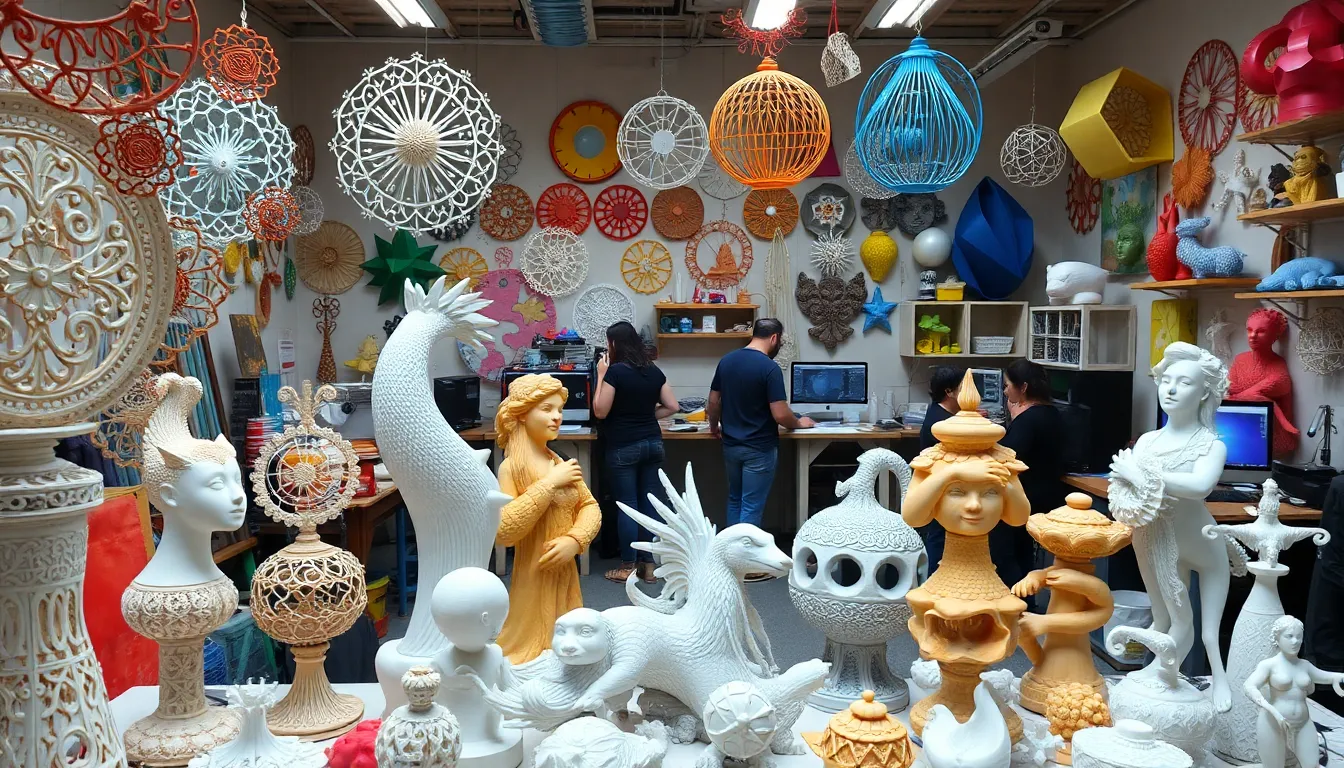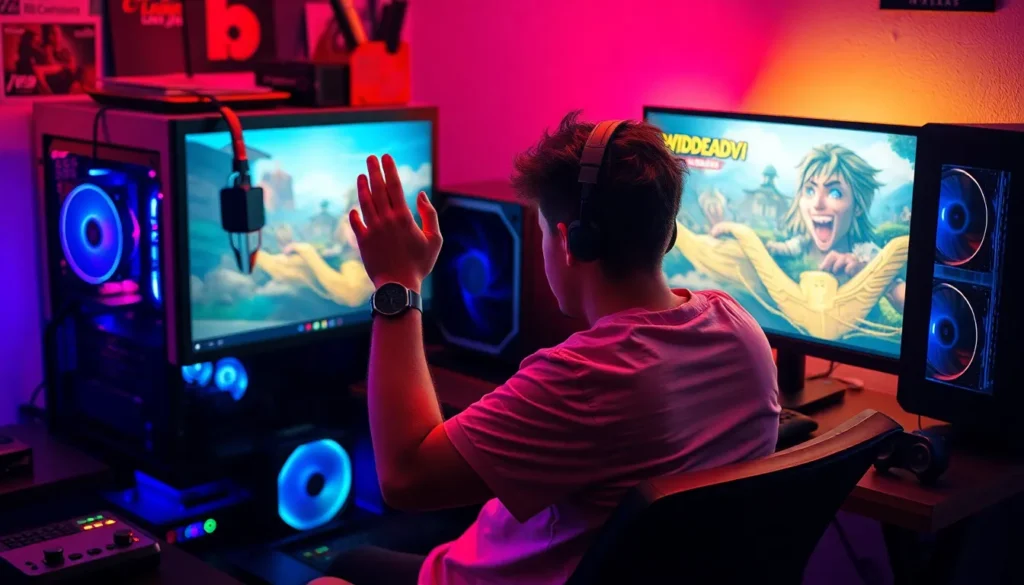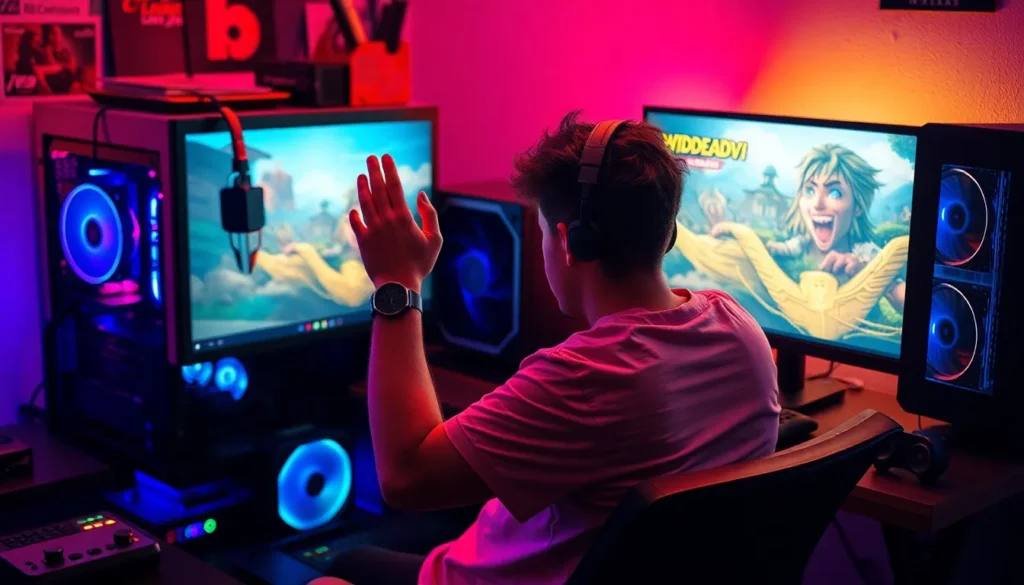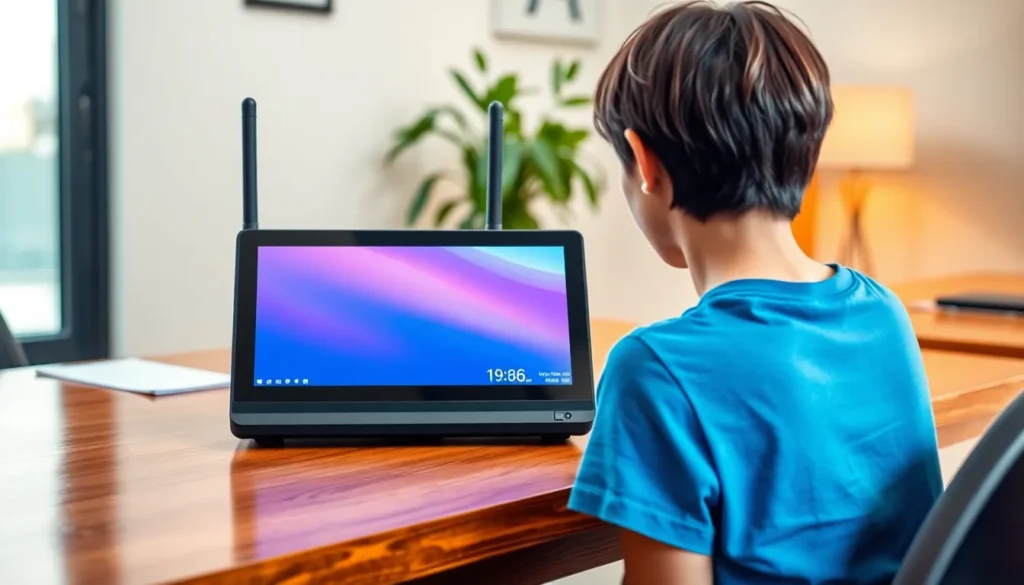3D printed art is revolutionizing the creative landscape, blending technology with traditional artistry in exciting new ways. Artists are now harnessing the power of 3D printing to push the boundaries of their imagination, crafting intricate sculptures and innovative designs that were once deemed impossible. This fusion of art and technology opens up endless possibilities, allowing creators to experiment with materials and forms like never before.
As the accessibility of 3D printing continues to grow, more artists are embracing this medium to express their unique visions. From delicate filigree to bold geometric shapes, 3D printed art captivates audiences with its complexity and detail. In this article, we’ll explore the fascinating world of 3D printed art, highlighting its evolution, techniques, and the impact it has on contemporary art movements.
Table of Contents
ToggleOverview of 3D Printed Art
3D printed art represents a significant shift in artistic creation, allowing artists to push creative boundaries and explore unique aesthetic possibilities. This technology enables the creation of detailed works that blend craftsmanship with innovation.
Definition of 3D Printed Art
3D printed art refers to artworks created using 3D printing techniques, which involve layering materials to form three-dimensional objects. Artists utilize various technologies, such as Fused Deposition Modeling (FDM) and Stereolithography (SLA), to produce varied forms, from sculptures to functional art pieces. This medium promotes experimentation, allowing for complex designs and intricate details that traditional methods may not achieve.
History and Evolution
The roots of 3D printed art trace back to the 1980s with the advent of 3D printing technologies for industrial applications. Over the years, artists began exploring this medium, showcasing its potential for artistic expressions. By the early 2000s, an emerging community of artists embraced 3D printing, incorporating it into their creative practices. Notable exhibitions have featured 3D printed sculptures and installations, marking a shift in contemporary art. As technology has progressed, access to 3D printing has increased, leading to a broader acceptance and integration of this medium within the art world. Today, 3D printed art continues to evolve, with artists pushing the limits of design and material use, influencing contemporary art movements across the globe.
Techniques in 3D Printing
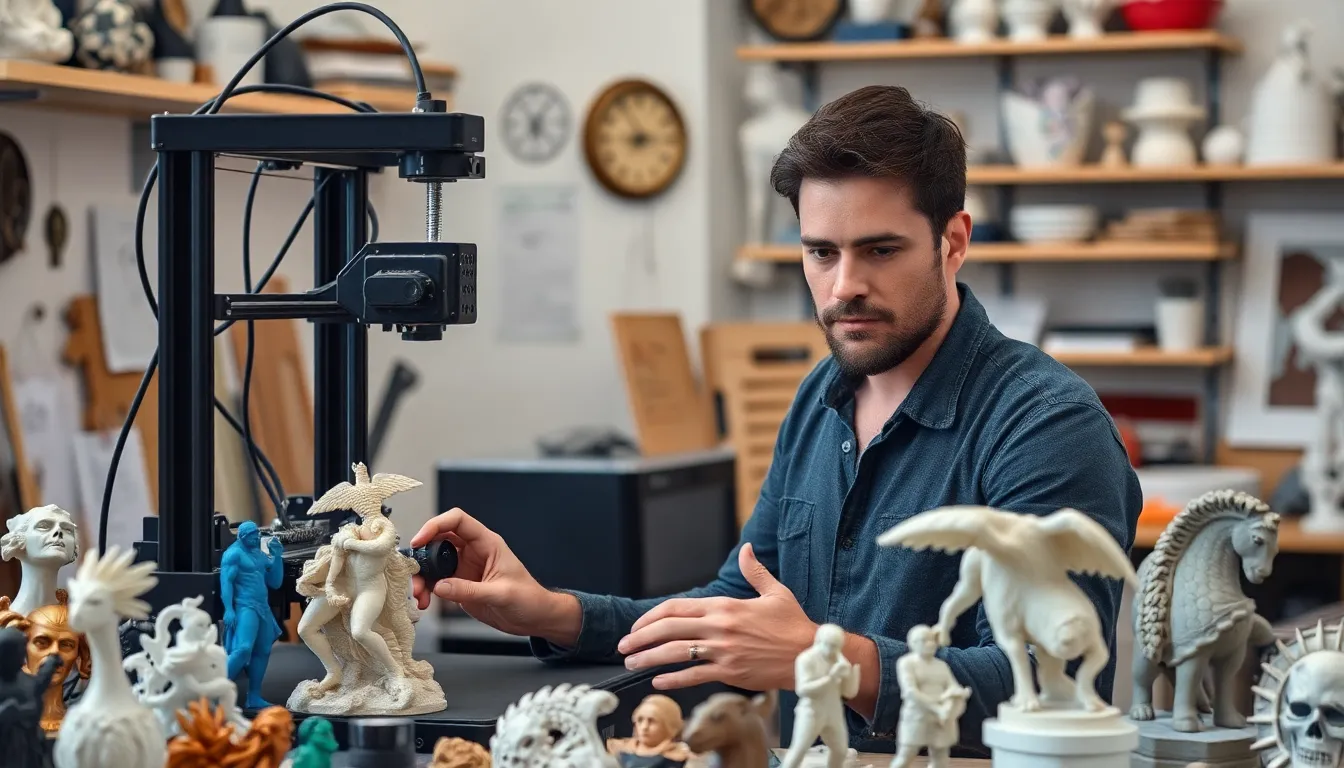
3D printing employs various techniques and materials, enabling artists to create intricate artworks. Understanding these technologies and materials enhances appreciation for the medium’s transformative capabilities.
Common 3D Printing Technologies
- Fused Deposition Modeling (FDM): FDM extrudes thermoplastic filament, layering melted material to build objects. It allows for precise control and is popular for producing detailed sculptures.
- Stereolithography (SLA): SLA utilizes a UV light source to cure liquid resin, layer by layer. This method is known for its ability to create high-resolution pieces with fine details and smooth finishes.
- Selective Laser Sintering (SLS): SLS uses a laser to fuse powder materials together, forming solid structures. It enables complex shapes and offers durability, making it suitable for functional art pieces.
- Digital Light Processing (DLP): DLP projects images onto resin, solidifying layers quickly. This method provides rapid printing and smooth surfaces, appealing to artists who prioritize speed and quality.
- Multi Jet Fusion (MJF): MJF applies agents to a powder bed, then uses heat to fuse materials. This technique creates strong, precise components, ideal for artworks that require intricate designs.
Materials Used in 3D Printed Art
- Thermoplastics: Common for FDM printing, thermoplastics such as PLA and ABS are versatile and easy to work with. Artists use them for their range of colors and availability.
- Resins: SLA and DLP processes typically involve resins, allowing for high detail and smooth finishes. Varying properties, like rigidity and flexibility, provide diverse artistic expressions.
- Metal Powders: SLS and MJF often utilize metal powders, enabling the creation of durable and complex sculptures. Metals like stainless steel and titanium lend a distinct quality to the artworks.
- Ceramics: Some artists explore ceramics in 3D printing, offering a unique aesthetic through traditional appearances and textures. These materials often require post-processing for additional durability.
- Composites: The combination of different materials, such as plastics reinforced with carbon fiber, enhances strength and visual appeal. Artists leverage composites for innovative designs with structural integrity.
Notable Artists and Their Works
Several artists have significantly contributed to the development of 3D printed art, pushing the boundaries of creativity. Their works showcase the vast potential of this medium, merging technology with artistic vision.
Pioneers of 3D Printed Art
- Janne Kyttanen: A trailblazer in the 3D printing field, Kyttanen’s work includes intricate, organic forms that challenge traditional sculpture. Notable pieces like the “GHOST Chair” highlight the blend of functionality and art.
- David M. Cummings: Known for his experimental approach, Cummings creates 3D-printed installations that explore human interaction and perception. His piece “The Dreamer” exemplifies the emotive potential of 3D printing.
- Neri Oxman: A leader in combining design, biology, and technology, Oxman’s projects, such as “Silk Pavilion,” incorporate natural materials. Her work investigates sustainable architecture through 3D printing techniques.
Contemporary Artists to Watch
- Joshua Harker: Harker’s intricate and detailed sculptures often reflect themes of life and death. His “Crown of the Future” series exemplifies his innovative approach to complex geometries in 3D printing.
- Elena Manferdini: Known for blending architecture and art, Manferdini’s works emphasize the aesthetic qualities of 3D printing. Projects like “Aria” showcase collaborative efforts to integrate technology into design.
- Andrew/Objectify: As a digital artist, Andrew records dynamic forms utilizing 3D printing. His work spans various mediums, demonstrating the versatility of 3D technologies in expressing artistic ideas.
These artists not only lead in their craft but also inspire the next generation of creators to explore the limitless possibilities of 3D printed art.
Impact of 3D Printed Art
3D printed art shapes cultural landscapes and addresses various challenges faced by artists and the art community. This impact spans cultural significance, challenges, and the ongoing controversies surrounding this innovative medium.
Cultural Significance
Cultural significance emerges as 3D printed art redefines traditional artistic boundaries and practices. These artworks encourage dialogue about technology’s role in creativity, prompting audiences to engage with new ideas and forms. Many artists utilize this medium to explore social issues, environmental concerns, and personal narratives, fostering a deeper connection with viewers. 3D printed art also democratizes the creation process, allowing more artists to participate regardless of their background. Exhibitions dedicated to 3D printed works gain traction in galleries and museums, further integrating this art form into the mainstream art conversation.
Challenges and Controversies
Challenges and controversies accompany the rise of 3D printed art, raising questions about authenticity, copyright, and the future of artistic production. Concerns about the originality of works generated through digital means challenge traditional notions of authorship. As 3D printing becomes widely available, discussions arise about the potential for mass production versus limited editions, which can dilute the perceived value of unique artifacts. Environmental issues also present challenges; while 3D printing can lower waste through precise material use, the choice of materials and energy consumption often comes under scrutiny. Balancing innovation with these concerns remains crucial for artists navigating the evolving landscape of 3D printed art.
Future of 3D Printed Art
The future of 3D printed art promises advancements and familiarity with the medium, paving the way for revolutionary changes in artistic practice. Artists and technologists continue to explore innovative applications that will reshape the creative landscape.
Innovations on the Horizon
Innovations in material science and printing technology are poised to enhance the capabilities of 3D printed art. Developments in biodegradable materials allow for eco-friendly art creation, while advancements in multi-material printing enable more complex and detailed designs. Integration of augmented reality (AR) with 3D printed pieces offers interactive experiences, engaging viewers on a new level. Research into artificial intelligence (AI) also suggests possibilities for AI-generated art, where algorithms collaborate with artists to produce unique works. The rise of larger-scale 3D printers may support monumental sculptures that challenge current spatial constraints.
Potential Trends
Potential trends indicate a growing democratization of 3D printing technology, allowing more artists to harness its power. Increased accessibility to 3D printing tools and software will likely lead to a rise in community-driven art projects. Cross-disciplinary collaborations between artists, engineers, and designers are expected to surge, fueling new forms of expression. Additionally, a focus on sustainability will likely prompt artists to prioritize environmentally responsible practices in material selection and energy use. The shift towards immersive and experiential art installations featuring 3D printed elements may redefine how audiences interact with art, fostering deeper connections and engagement.
3D printed art is redefining the boundaries of creativity and expression. As artists embrace this innovative medium they’re not just creating visually stunning pieces but also engaging with critical social and environmental issues. The fusion of technology and artistry opens up new avenues for exploration and collaboration.
With advancements in materials and techniques on the horizon the future of 3D printed art looks promising. This evolving landscape encourages artists to push their limits while fostering a deeper connection with audiences. As accessibility increases the potential for community-driven projects and cross-disciplinary collaborations will only grow. The journey of 3D printed art is just beginning and its impact on the art world will undoubtedly continue to expand.

